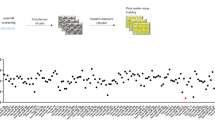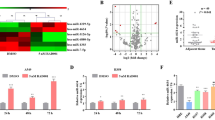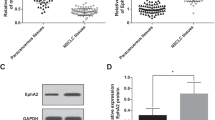Abstract
Non-small cell lung cancer (NSCLC) accounts for ∼80% of all lung cancers. Although some advances in lung cancer therapy have been made, patient survival is still quite poor. Two microRNAs, miR-221 and miR-222, upregulated by the MET proto-oncogene, have been already described to enhance cell survival and to induce TNF-related apoptosis-inducing ligand (TRAIL) resistance in NSCLC cell lines, through the downregulation of p27kip1, PTEN and TIMP3. Here, we further investigated this pathway and showed that miR-130a, expressed at low level in lung cancer cell lines, by targeting MET was able to reduce TRAIL resistance in NSCLC cells through the c-Jun-mediated downregulation of miR-221 and miR-222. Moreover, we found that miR-130a reduced migratory capacity of NSCLC. A better understanding of MET-miR-221 and 222 axis regulation in drug resistance is the key in developing new strategies in NSCLC therapy.
This is a preview of subscription content, access via your institution
Access options
Subscribe to this journal
Receive 50 print issues and online access
$259.00 per year
only $5.18 per issue
Buy this article
- Purchase on Springer Link
- Instant access to full article PDF
Prices may be subject to local taxes which are calculated during checkout




Similar content being viewed by others
References
Ambros V . (2004). The functions of animal microRNAs. Nature 431: 350–355.
Birchmeier C, Gherardi E . (1998). Developmental roles of HGF/SF and its receptor, the c-Met tyrosine kinase. Trends Cell Bio 8: 404–410.
Cecchi F, Rabe DC, Bottaro DP . (2010). Targeting the HGF/Met signalling pathway in cancer. Eur J Cancer 46: 1260–1270.
Cimmino A, Calin GA, Fabbri M, Iorio MV, Ferracin M, Shimizu M et al. (2006). miR-15 and miR-16 induce apoptosis by targeting BCL2. Proc Natl Acad Sci USA 103: 2464.
Croce CM . (2009). Causes and consequences of microRNA dysregulation in cancer. Nat Rev Genet 10: 704–714.
Dérijard B, Hibi M, Wu IH, Barrett T, Su B, Deng T et al. (1994). JNK1: a protein kinase stimulated by UV light and Ha-Ras that binds and phosphorylates the c-Jun activation domain. Karin M, Davis RJ. Cell 76: 1025–1037.
Fan S, Ma YX, Gao M, Yuan RQ, Meng Q, Goldberg ID et al. (2004). The multisubstrate adapter Gab1 regulates hepatocyte growth factor (scatter factor)-c-Met signaling for cell survival and DNA repair. Mol Cell Biol 21: 4968–4984.
Gao W, Yu Y, Cao H, Shen H, Li X, Pan S et al. (2010). Deregulated expression of miR-21, miR-143 and miR-181a in non small cell lung cancer is related to clinicopathologic characteristics or patient prognosis. Biomed Pharmacother 64: 399–408.
Garofalo M, Di Leva G, Romano G, Nuovo G, Suh SS, Ngankeu A et al. (2009). miR-221&222 regulate TRAIL resistance and enhance tumorigenicity through PTEN and TIMP3 downregulation. Cancer Cell 16: 498–509.
Garofalo M, Quintavalle C, Di Leva G, Zanca C, Romano G, Taccioli C et al. (2008). MicroRNA signatures of TRAIL resistance in human non-small cell lung cancer. Oncogene 27: 3845–3855.
Hummel R, Hussey DJ, Haier J . (2010). MicroRNAs: predictors and modifiers of chemo- and radiotherapy in different tumour types. Eur J Cancer 46: 298–311.
Incoronato M, Garofalo M, Urso L, Romano G, Quintavalle C, Zanca C et al. (2010). miR-212 increases tumor necrosis factor-related apoptosis-inducing ligand sensitivity in non-small cell lung cancer by targeting the antiapoptotic protein PED. Cancer Res 70: 3638–3646.
Mariani SM, Matiba B, Armandola EA, Krammer PH . (1997). Interleukin 1 beta-converting enzyme related proteases/caspases are involved in TRAIL-induced apoptosis of myeloma and leukemia cells. J Cell Biol 137: 221–229.
Peruzzi B, Bottaro DP . (2006). Targeting the c-Met signaling pathway in cancer. Clin Cancer Res 12: 3657–3660.
Ramalingam S, Pawlish K, Gadgeel S, Demers R, Kalemkerian GP . (1998). Lung cancer in young patients: analysis of a surveillance, epidemiology, and end results database. J Clin Oncol 16: 651–657.
Schaefer U, Voloshanenko O, Willen D, Walczak H . (2007). TRAIL: a multifunctional cytokine. Front Biosci 12: 3813–3824.
Segarra J, Balenci L, Drenth T, Maina F, Lamballe F . (2006). Combined signaling through ERK, PI3K/AKT, and RAC1/p38 is required for met-triggered cortical neuron migration. J Biol Chem 281: 4771–4778.
Socinski MA, Crowell R, Hensing TE, Langer CJ, Lilenbaum R, Sandler AB et al. (2007). American College of Chest Physicians. Treatment of non-small cell lung cancer, stage IV: ACCP evidence-based clinical practice guidelines (2nd edition). Chest 132: 277S–289S.
Song H, Moon A . (2006). Glial cell-derived neurotrophic factor (GDNF) promotes low-grade Hs683 glioma cell migration through JNK, ERK-1/2 and p38 MAPK signaling pathways. Neurosci Res 56: 29–38.
Sorrentino A, Liu CG, Addario A, Peschle C, Scambia G, Ferlini C . (2008). Role of microRNAs in drug-resistant ovarian cancer cells. Gynecol Oncol 111: 478–486.
Tulasne D, Foveau B . (2007). The shadow of death on the MET tyrosine kinase receptor. Cell Death Differ 15: 427–434.
Walczak H, Miller RE, Ariail K, Gliniak B, Griffith TS, Kubin M et al. (1999). Tumoricidal activity of tumor necrosis factor-related apoptosis-inducing ligand in vivo. Nat Med 5: 146–147.
Wiley SR, Schooley K, Smolak PJ, Din WS, Huang CP, Nicholl JK et al. (1995). Identification and characterization of a new member of the TNF family that induces apoptosis. Immunity 3: 673–682.
Yang H, Kong W, He L, Zhao JJ, O'Donnell JD, Wang J et al. (2008). MicroRNA expression profiling in human ovarian cancer: miR-214 induces cell survival and cisplatin resistance by targeting PTEN. Cancer Res 68: 425–433.
Acknowledgements
This study was supported by the NCI grants to (CMC) and Associazione Italiana Ricerca sul Cancro, AIRC grant to GC.
We thank Veronica Balatti, Giampiero di Leva, Claudia Piovan, Hansjuerg Alder and Paolo Fadda for the helpful discussions about this manuscript.
Author information
Authors and Affiliations
Corresponding author
Ethics declarations
Competing interests
The authors declare no conflict of interest.
Additional information
Supplementary Information accompanies the paper on the Oncogene website
Rights and permissions
About this article
Cite this article
Acunzo, M., Visone, R., Romano, G. et al. miR-130a targets MET and induces TRAIL-sensitivity in NSCLC by downregulating miR-221 and 222. Oncogene 31, 634–642 (2012). https://doi.org/10.1038/onc.2011.260
Received:
Revised:
Accepted:
Published:
Issue Date:
DOI: https://doi.org/10.1038/onc.2011.260
Keywords
This article is cited by
-
A-to-I edited miR-411-5p targets MET and promotes TKI response in NSCLC-resistant cells
Oncogene (2023)
-
Apoptotic functions of microRNAs in pathogenesis, diagnosis, and treatment of endometriosis
Cell & Bioscience (2020)
-
Noncoding RNAs: the shot callers in tumor immune escape
Signal Transduction and Targeted Therapy (2020)
-
Combination therapy with c-met inhibitor and TRAIL enhances apoptosis in dedifferentiated liposarcoma patient-derived cells
BMC Cancer (2019)
-
A novel miRNA identified in GRSF1 complex drives the metastasis via the PIK3R3/AKT/NF-κB and TIMP3/MMP9 pathways in cervical cancer cells
Cell Death & Disease (2019)



